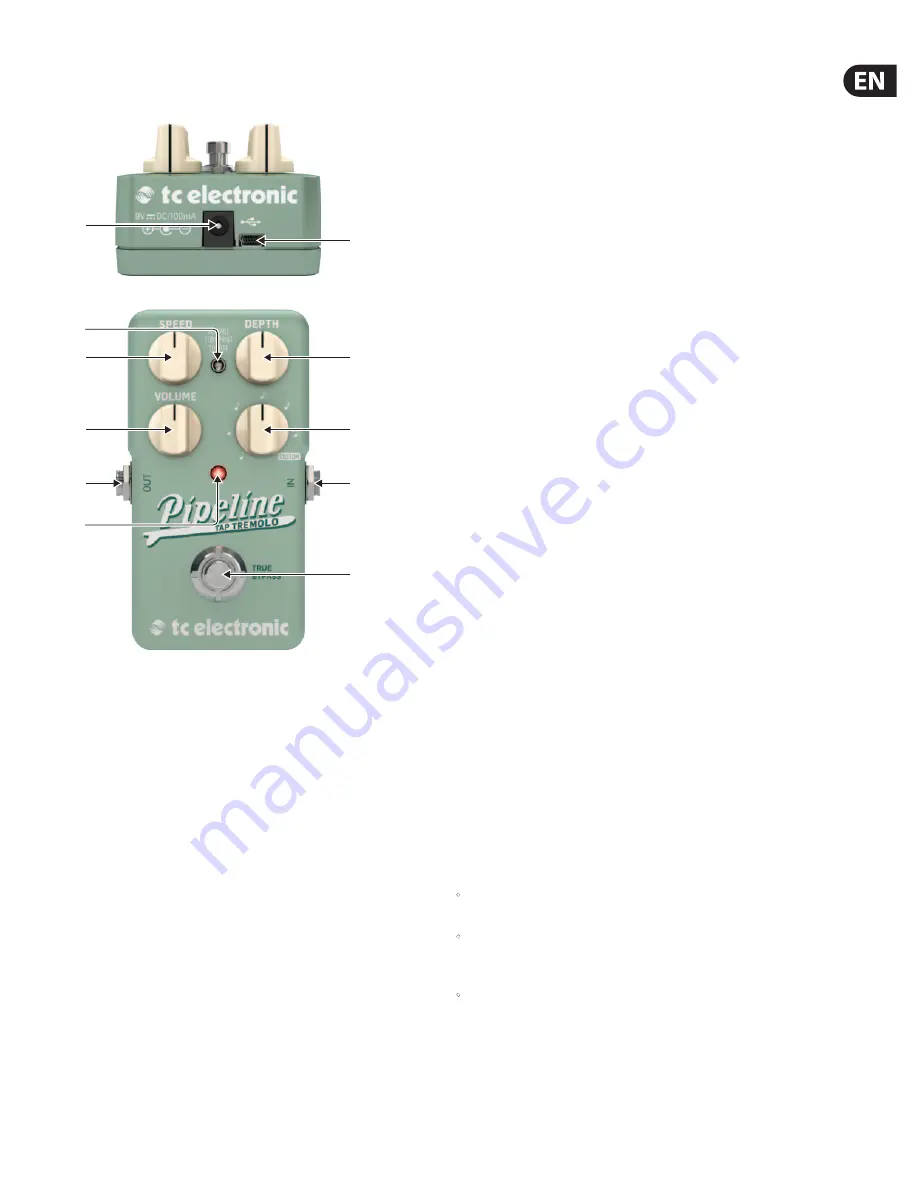
5
PIPELINE TAP TREMOLO User Manual
3. Operation – Inputs,
Outputs and Controls
3.1 Power / Computer connection
(1)
POWER input
To power up your pedal, connect a power supply to its power
input socket. The power input socket of your TC ELECTRONIC effect pedal is a
standard 5.5/2.1 mm DC plug (centre = negative).
Your TC ELECTRONIC effect pedal requires a 9 V power supply providing
100 mA or more (not supplied). TC ELECTRONIC recommends using the
PowerPlug 9.
To minimize hum, use a power supply with isolated outputs.
If no power supply is available, you can run this product using a battery.
For more information on changing batteries, see “7.2 Changing the battery”.
(2)
USB port
Use the standard Mini-B USB port on your TC ELECTRONIC effect
pedal to connect your pedal to a computer. This will allow you to load
TonePrints into the pedal or create your own TonePrint using TC’s TonePrint
Editor. For more information, see “5. Operation – TonePrint”.
If there should be firmware updates for this pedal, they can also be installed
using the USB port – see “7.1 Updating the firmware”.
3.2 Switching
(3)
FOOTSWITCH
To turn the effect on, tap the footswitch. To turn the effect off,
tap the footswitch again.
(4)
INDICATOR LED
The LED lights up red when the effect is switched on.
In Tap Tempo mode, the LED will switch to green (see “4.1 Tap Tempo”
for more information).
3.3 Audio in and out
(5)
AUDIO INPUT (mono)
The audio input on the right side of this pedal is a
standard 1⁄4" jack (mono/TS). Connect your guitar to the audio input on the
right side of your pedal using a regular 1⁄4” mono cable.
(6)
AUDIO OUTPUT (mono)
The audio output on the left side of this pedal is a
standard 1⁄4" jack (mono/TS). Connect the audio output of your pedal to the
next device in the signal chain using a regular 1⁄4” mono cable.
3.4 Effect controls
Please note that the knob assignments on your TC ELECTRONIC effect pedal are
the default assignments. Using the TonePrint Editor, you can rewire all knobs
so they control one or several parameters of your choice. For more information,
see “5.3 Editing TonePrints with TonePrint Editor”.
Unlike effects such as chorus, phaser or rotating speaker simulation, which use
modulation and wave-interference to create a warbling pulsation, a tremolo
effect works strictly by varying the volume in a repeating wave-like pattern.
The shape of the wave pattern (sine, triangle, square wave, and so on)
determines how quickly the volume varies between peaks and troughs, with sine
or triangular waveforms producing a gentler sound, while a square wave can
produce a more intense strobing effect.
(7)
SPEED knob
The SPEED knob controls the time between the “peaks” of the
tremolo effect. Turn the knob clockwise for a faster tremolo, or turn the knob
counter-clockwise to slow down the tremolo.
(8)
DEPTH knob
The DEPTH knob controls the intensity of the tremolo effect.
Turning the knob clockwise increases the volume difference between the
effect’s peaks and troughs to produce a more intense pulsation, while
turning the knob counter-clockwise shifts the sound toward a more gentle
shimmer with a smaller volume difference between peaks and troughs.
(9)
VOLUME knob
The VOLUME knob varies the output level from unity gain
to 6 dB of additional boost. The additional boost compensates for the ear’s
tendency to perceive an overall drop-off in volume when the tremolo effect
is activated. So, if the volume seems to drop when you switch on the pedal,
turn the VOLUME clockwise until the perceived volume sounds closer to the
un-effected, dry volume.
(10)
SUBDIVISION
knob The SUBDIVISION knob lets you set the tremolo to
rhythmic subdivisions or patterns versus the active quarter note tempo.
The SUBDIVISION knob can the following subdivisions: quarter note,
quarter note triplet, eighth note, eighth note triplet, sixteenth note,
sixteenth note triplet, and then a CUSTOM setting that lets you access the
Sequencer function, which lets you set up a string of changing subdivisions.
For more information, see “4. Operation – Tap Tempo, Subdivisions/
Sequencer and LFOs”.
(11)
MODE selector
The MODE switch alters the circuit operation to suit
different situations:
•
Vintage
Set the MODE selector to “Vintage” to get classic tremolo sounds
like those found on some vintage guitar amplifiers.
•
TonePrint
To use TonePrint-based LFO waveforms and custom subdivision
sequences, set the MODE selector to “TonePrint”. For more information,
see “5. Operation – TonePrint”.
•
Square
Set the MODE selector to “Square” when you want a tremolo sound
with a more intense, strobing, on-off quality.
(3)
(5)
(10)
(8)
(2)
(6)
(9)
(7)
(1)
(11)
(4)
Summary of Contents for Pipeline TAP TREMOLO
Page 10: ......










